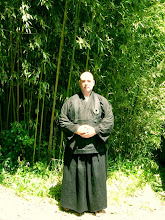
Beginning on Wednesday, a new component will be integrated into the daily practice. I will touch on it now so that any reader who may be following along with their own practice (I don't think that this is actually happening, to be honest... but, it can't hurt.) may have a few days to give this new meditation method some thought and have some time to internalize it before it becomes a part of the daily scheduled practice.
Wednesday, 16 July, begins "Noting & Observation Practice". Here are a few notes which describe the practice, and give some hints on how to correctly go about it. Naturally, each person's practice will be their own, and there is a great deal of trial and error, but, as in most practices, there are common areas of experience. This is what I hope to address.
Noting & Observation Practice:
This is a meditation practice which essentially uses the breath as a point of focus such as observing the breath as it is without changing it in any way. You do this by observing every nuance of the breath and each sensation it produces: how it moves in your abdomen and torso, how it feels as it moves in and out of your nose, its quality, its temperature, and so on. Though you are fully aware of all these details, you don't dwell on them or judge them in any way; you remain detached from what you're observing. Or you may mentally think "in" while being aware of the breath coming in the nostrils and "out" while being aware of the breath leaving out of the nostrils. Then shift to simply observing the breath, noticing its own natural rhythm and its movement in your torso. If you wish to try something slightly different, you might try using earplugs (this sounds strange, I know.. but…;) By using earplugs you can increase your concentration on the sound of your breath. Initially, I recommend simply focusing your attention on the sensation of your breath at the point where it enters and exits the body; the nostrils. Feel the inrush and outflow of air, the various physical sensations that this engenders, etc.Another way to observe the breath is to count it. Breathe in for 3 to 7 counts and breathe out for the same length of time. Another way to count breaths is to count breathing cycles. Inhale normally and then count on the exhale. Count up to 4 then start over. Or count the breaths from one to ten and then start again. Do this by inhaling and mentally counting one, then exhaling and counting two. Begin again when you reach ten.
A secondary method of practicing observing and noting is to focus on some other physical sensation. This involves focusing on a physical sensation such as how hot or cold your hands feel, or on a particular emotion or any area of discomfort you feel. Whatever you choose remains your point of focus for the whole practice. Observing a physical sensation - becoming keenly aware of all its intricacies and yet remaining detached - can be more challenging than observing the breath. I do not recommend this method for those who are just beginning meditation.
Observing & Noting practice is a particular form of Concentration practice. This is not the only method, nor is it the best or the worst method. It is simply one method. When we follow a formal practice, there must be some type of ‘form’ in order for the practice to be in any way formal. Any time we embark upon some type of formal practice, we sacrifice some degree of spontaneity and dynamism in exchange for a tried and true, dependable formula by which we can be assured of learning the various concepts, attributes and skills to ensure our future development. This is a formal practice, and, as such, will appear somewhat stilted and regimented. By staying to the course, however, we are led, step by step to a departure point at which we may then set down the regimentality of formal practice and follow our own guiding spirit; but with a solidly built and tested foundation upon which to build.
At No extra charge, I want to comment a bit on Mindfulness Practice, as well... as it is more or less a parent of Noting and Observation Practice, and should probably be discussed, at least briefly.





1 comment:
How does the monk know I am not following? "He who knows silence knows a wise man"
Post a Comment